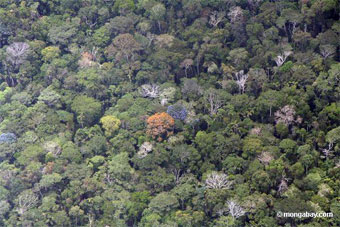Carbon trading could save rainforests
Rhett A. Butler, mongabay.com
April 12, 2006
A new rainforest conservation initiative by developing nations offers great promise to help slow tropical deforestation rates says William Laurance, a leading rainforest biologist from the Smithsonian Tropical Research Institute in Panama, in an article appearing Friday in New Scientist.
Laurance, who is also president of the Association for Tropical Biology and Conservation, says the proposal “basically involves selling or renting rainforests to help protect the billions of tons of carbon they store, thereby slowing the rapid buildup of carbon dioxide and other greenhouse gases in the atmosphere.”
The new initiative, proposed by an alliance of ten developing countries led by Papua New Guinea, would establish a mechanism by which industrialized countries would compensate tropical countries for the services rainforests provide the rest of the world, focusing initially on carbon sequestration by forests. Forests play an important role in the carbon cycle. As forests grow, they absorb atmospheric carbon into their tissues via photosynthesis. The opposite occurs when they are cut, thinned and degraded: carbon is released into the atmosphere, contributing to global warming. The UN estimates that 20-25 percent of greenhouse gas emissions come from the destruction and degradation of forests, an amount similar to the volume produced each year by the United States.
Tropical forests have the best potential for mitigating rising concentrations of greenhouse gases since have the greatest capacity to store carbon in their tissues as they grow. Some experts estimate that the reforestation of 3.9 million square miles (10 million square km) could sequester 100-150 billion metric tons of carbon dioxide over the next 50-100 years.
 Seeing green? Monkey frog, a large tree frog found in the rainforest of Peru. Currently, the world carbon credit market is a $450 million marketplace, but it is expected to grow to a $23 billion one by 2010. Avoided deforestation could help fight third world poverty under global warming pact — 10/31/2006 Avoided deforestation will be a hot point of discussion at next week’s climate meeting in Nairobi, Kenya. Already a coalition of 15 rainforest nations have proposed a plan whereby industrialized nations would pay them to protect their forests to offset greenhouse gas emissionsm. Meanwhile, last month Brazil — which has the world’s largest extent of tropical rainforests and the world’s highest rate of forest loss — said it promote a similar initiative at the talks. At stake: potentially billions of dollars for developing countries. When trees are cut greenhouse gases are released into the atmosphere — roughly 20 percent of annual emissions of such heat-trapping gases result from deforestation and forest degradation. Avoided deforestation is the concept where countries are paid to prevent deforestation that would otherwise occur. Policymakers and environmentalists alike find the idea attractive because it could help fight climate change at a low cost while improving living standards for some of the world’s poorest people and preserving biodiversity and other ecosystem services. A number of prominent conservation biologists and development agencies including the World Bank and the U.N. have already endorsed the idea. World Bank says carbon trading will save rainforests Monday the World Bank endorsed carbon trading as a way to save tropical rainforests increasingly threatened by logging, agricultural development, subsistence agriculture, and climate change itself. In its report, “At Loggerheads? Agricultural Expansion, Poverty Reduction and Environment in the Tropical Forests”, the bank estimates that deforested land worth $200-500 per hectare as pasture could be worth $1,500-$10,000 if left as intact forest and used to offset carbon emissions from industrialized countries. |
Under the proposed scheme, in helping developing countries slow deforestation, industrial nations would earn ‘carbon credits’ that would count toward their emissions targets under the Kyoto Protocol or other international agreements.
“It’s potentially a win-win situation for everybody involved,” said Laurance. “The forests win, the atmosphere wins, the international community wins, and developing nations struggling to overcome poverty win.”
“Of course, the devil is in the details,” Laurance admits. He notes that “earlier efforts to establish rainforest-carbon trading under Kyoto were defeated, in part because countries couldn’t agree about whether and how to credit countries that slowed forest destruction.”
Nevertheless, the Coalition for Rainforest Nations’ proposal is gaining ground. In December 2005 at the United Nations Framework Convention on Climate Change in Montreal, the U.N. agreed in principal to support the initiative and even the U.S., which initially opposed the proposal, expressed interest.
A lot is at stake for developing countries. Focusing specifically on the value of carbon sequestration the coalition could be talking a lot of money. At the current going rate of $20 for a one-ton unit of carbon dioxide, the forests of Bolivia, Central African Republic, Chile, Congo, Costa Rica, Democratic Republic of Congo, the Dominican Republic, Guatemala, Nicaragua, and Papua New Guinea (coalition members) are worth around $1.1 trillion for their carbon sequestration alone. Of course the forests offer a great deal more value through the other, less measurable services they provide including fisheries protection, biodiversity preservation, erosion and flood control, recreation and tourism value, harvest of renewable products, and water services.
For comparison, a recent study by the Pembina Institute for the Canadian Boreal Initiative found that carbon stored in Canada’s boreal forests and peatlands is worth $3.7 trillion, while the annual value of ecosystem services like water filtration, pest-control services, and carbon storage at $93 billion — roughly 2.5 times greater than the net market value of forestry, hydroelectric, mining, and oil and gas extraction in Canada’s Boreal region. The values can be expected to be similar in tropical countries.
Deforestation of tropical rainforests has a global impact through species extinction, the loss of important ecosystem services and renewable resources, and the reduction of carbon sinks. Recently a study by NASA found a direct impact that tropical deforestation has on the economies of the United States and Europe. Research shows that deforestation in the Amazon region of South America influences rainfall from Mexico to Texas and in the Gulf of Mexico, while forest loss in Central Africa affects precipitation patterns in the upper and lower U.S Midwest. Similarly, deforestation in Southeast Asia was found to influence rainfall in China and the Balkan Peninsula.
While the potential benefits seem clear, no one expects that implementing the proposal will be simple.
 Peruvian rainforest The world carbon credit market registered deals worth $11.3 billion euros last year, up sharply from $452 million in 2004 according to Econergy, New York-based clean energy investment, management and consulting group. |
“There are still many hurdles to clear,” said Laurance. “But a key point is that, if a viable rainforest-carbon trading mechanism is established, the perverse economic logic that currently drives rapid forest destruction could be profoundly altered. That would make us all breath a little easier.”
Should the initiative come into being, it is likely that it would include provisions for the restoration of degraded forests and the development of plantations on deforested lands. Tropical countries would then have an incentive to begin replanting the forests that have so rapidly been lost due to logging, commercial and subsistence agriculture, and other forms of development over the past 50 years. Already, private companies are positioning themselves to cash in on the potential windfall. Several firms, including Carbon Capital in London, are forming trading partnerships with developing countries, while others are establishing plantations in tropics.
The nascent carbon trading market could prove to be a model for financing large-scale conservation while simultaneously providing profit opportunities for private firms. While corporations pursuing commercial interests could end up doing a lot of good for the global environment, poor countries could have a new way to capitalize on their natural assets without destroying them.
This article used information and quotes from a news release from the Smithsonian Tropical Research Institute. This article also used excerpts from past mongabay.com articles.